| Author |
 Topic Topic  |
|
Stanley
Local Historian & Old Fart
    

36804 Posts

|
|
 Posted -
25/11/2004
:
14:20 Posted -
25/11/2004
:
14:20
|
I've always been fascinated by the things people do in their spare time when they can do exactly what they want to do. Men and sheds are a particularly fertile field. Women tend to do their thing in the comfort of the house.
I was delighted to see Andy's picture of the clock movement he has made.
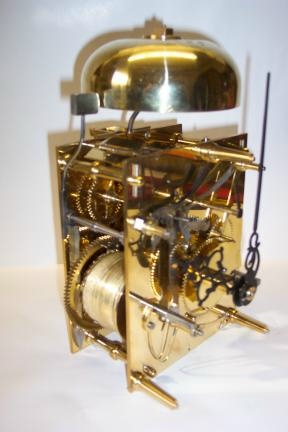
It struck me that we could perhaps start a new topic devoted to spare time skill. So Andy starts it off and my contribution is this:
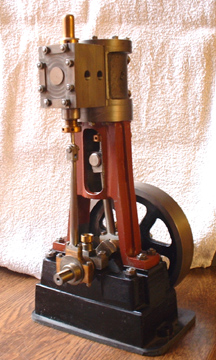
It's a small steam engine made from scratch and is based on the Stuart 5A but a longer stroke. One of these will drive a 14 foot boat with steam at 250psi. By the way, we don't like to call them models, it's exactly the same construction and materials as a full size engine, just smaller. So come on out there, let's hear about what you make in your spare time. I reckon we could be in for some surprises!
Stanley Challenger Graham

Barlick View
stanley at barnoldswick.freeserve.co.uk
|
|
| Replies |
| Author |
|
|
Mercury
Regular Member


233 Posts
|
|
 Posted - 28/02/2007 : 19:11 Posted - 28/02/2007 : 19:11
Of course! I thought about this driving home from work - the hob is a helical cutter, so if the blank is free to rotate, it's going to pull it round naturally. Thanks for clarifying, Stanley.
Before I read this thread I thought a hob was only for cooking on! This site is just amazing and I'm hooked.
Edited by - Mercury on 28 February 2007 19:13:53
 |
Stanley
Local Historian & Old Fart
    

36804 Posts

|
|
 Posted - 01/03/2007 : 08:21 Posted - 01/03/2007 : 08:21
If you were doing a really heavy worm wheel to carry a drive free-hobbing would be no good. You'd have to have a powered drive to the blank coupled to the speed of the cutter, same set up as you'd have for spiral milling. Bit like ornamental turning on the miller. For really heavy cuts another way is to gash the wheel using dividing gear and just use the cutter to clean the cut up and get the profile right. That's what I would do if I had to make one and it would free hob once you had done that because it would index itself taking the line of least resistance. That's where the set up I made would come in handy because you can angle the head in two orientations to gash in any way you wanted. It would be handy for bevels as well. Can't wait to get the chores out of the way and get back in there!
Stanley Challenger Graham

Barlick View
stanley at barnoldswick.freeserve.co.uk  |
Stanley
Local Historian & Old Fart
    

36804 Posts

|
|
 Posted - 01/03/2007 : 17:51 Posted - 01/03/2007 : 17:51
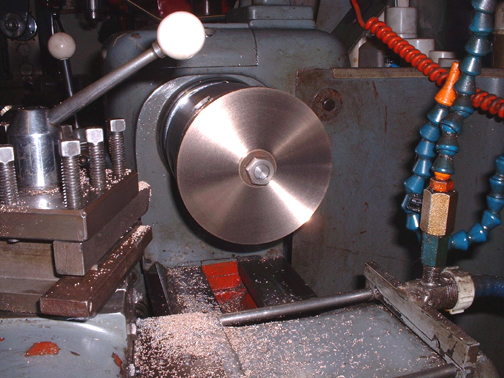
Getting near a blank for the gear. Just needs turning down to 4.9 inches....... A bit of light turning tomorrow and then some hobbing and tooth counting! What are the odds on getting the right number first time?
Stanley Challenger Graham

Barlick View
stanley at barnoldswick.freeserve.co.uk  |
Stanley
Local Historian & Old Fart
    

36804 Posts

|
|
 Posted - 05/03/2007 : 10:48 Posted - 05/03/2007 : 10:48

Not a lot been done for two days, I have been engaged in other matters. However, I gave a bit of thought last night to acheiving fine finishes in the lathe. One of the best aspects of Johnny's work was that he could get very fine machined finishes which didn't need any other treatment. Nothing looks better than a good machined finish straight off the lathe. He had an advantage in that he was using belt-driven lathes which give the best finish because there is no variation or vibration in the drive. Geared lathes like the Harrison are excellent but even the best gear transmits a vibration to the workpiece. You can get round this by very careful tool sharpening and set up. I had a go at this last night and the solution was a very heavy tipped tool with a round nose and you can see the finish this has given on the gear blank. Using a big tool means that there is the least chance of vibration in the tool or the saddle. It looks silly using a cutting tool this size but as you can see, it works.
Stanley Challenger Graham

Barlick View
stanley at barnoldswick.freeserve.co.uk  |
Stanley
Local Historian & Old Fart
    

36804 Posts

|
|
 Posted - 05/03/2007 : 16:16 Posted - 05/03/2007 : 16:16

We've had a good day. Here's the blank being hobbed. All very professional looking but actually a complete cock-up as it had 185 teeth! I took it out and turned a bit off and tried again. After four goes I got it right but then realised I had another problem, I couldn't get any weight on the cut because the heas of the fixture holding the blank was rotating out of vertical. Thinking cap on!
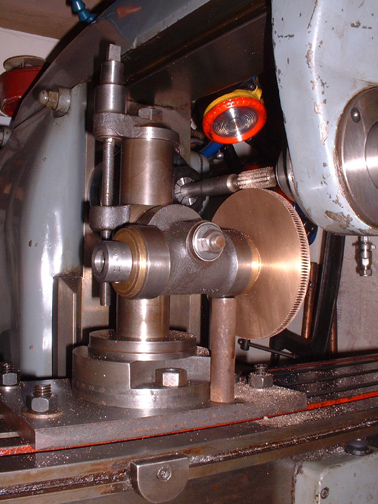
Spot the difference! A piece of bar turned to size and inserted under the end of the head for a prop. I had found that it was best to have the blank fast on the shaft and let the shaft turn. As it's on a taper bearing this meant it had no play. I just carried on hobbing until it looked deep enough. I took it out, wire-brushed the teeth, turned a chafer on each shoulder and then just for a laugh I measured the blank size that had produced the right number of teeth. As I suspected it was the pitch circle diameter plus a third of the tooth depth, 4.8 inches.
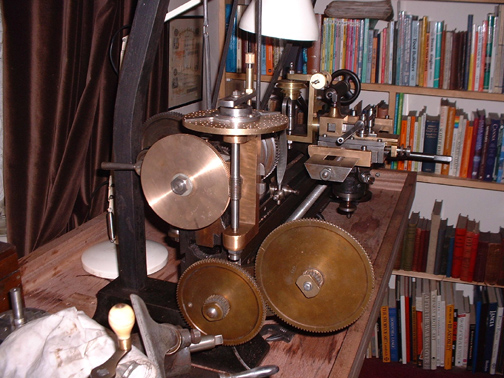
Here we are at last. The 1927 lathe is now a fully equipped OT lathe with it's tangential dividing gear. Funny thing is that Johnny's indexing worm wouldn't go completely into mesh with the worm but it must be the same size as his was. I had to file a couple of corners off to get it completely in gear with no backlash. One turn of the index worm gives 2 degrees of movement on the mandrel...... Very satisfying and I shall now move on to the next improvement. I want to make holders for storing the OTslide rest when not in use.....
Stanley Challenger Graham

Barlick View
stanley at barnoldswick.freeserve.co.uk  |
Stanley
Local Historian & Old Fart
    

36804 Posts

|
|
 Posted - 07/03/2007 : 07:52 Posted - 07/03/2007 : 07:52
Yesterday was clearing up and a spell of milling cutter sharpening on the Clarkson T&C grinder. It doesn't do any harm to sharpen the tools every now and again!
Stanley Challenger Graham

Barlick View
stanley at barnoldswick.freeserve.co.uk  |
Stanley
Local Historian & Old Fart
    

36804 Posts

|
|
 Posted - 07/03/2007 : 17:39 Posted - 07/03/2007 : 17:39
I had a visitor today..... Suffice it to say he didn't leave a horse's head but that may be because I plied him with gifts. Was this the right tactic?
Stanley Challenger Graham

Barlick View
stanley at barnoldswick.freeserve.co.uk  |
Another
Traycle Mine Overseer
  

6250 Posts

|
|
 Posted - 07/03/2007 : 18:27 Posted - 07/03/2007 : 18:27
I doubt he would have tried the equestrian tactic given your links with the Denton Mafia. Sorry Nandy, I'll pay double next week. Nolic
" I'm a self made man who worships his creator"   |
Stanley
Local Historian & Old Fart
    

36804 Posts

|
|
 Posted - 08/03/2007 : 07:25 Posted - 08/03/2007 : 07:25
I know he won't thank me for this but did you know he's a very talented Ornamental Turner? he showed me a beautiful example of his work that won the major UK prize in the field. We had a good couple of hours and he gave me some useful clues...... A man of many parts is our Nandy! I had some clock parts that I've collected over the years and gave them to him. He told me something interesting about clock faces, they were often made from recycled coffin plates. Now how the hell did they migrate from a grave to a clockmaker's bench?
Stanley Challenger Graham

Barlick View
stanley at barnoldswick.freeserve.co.uk  |
Another
Traycle Mine Overseer
  

6250 Posts

|
|
 Posted - 08/03/2007 : 12:18 Posted - 08/03/2007 : 12:18
How the heck does anyone get hold of re-cycled coffin plates? Oh no, he's not into his Burke and Hare activities again. Is he? Nolic
" I'm a self made man who worships his creator"   |
Ringo
Site Administrator
 

3793 Posts

|
|
 Posted - 08/03/2007 : 12:27 Posted - 08/03/2007 : 12:27
How the heck does anyone get hold of re-cycled coffin plates?
I know where to get them from !!!!!
 |
Stanley
Local Historian & Old Fart
    

36804 Posts

|
|
 Posted - 08/03/2007 : 17:53 Posted - 08/03/2007 : 17:53
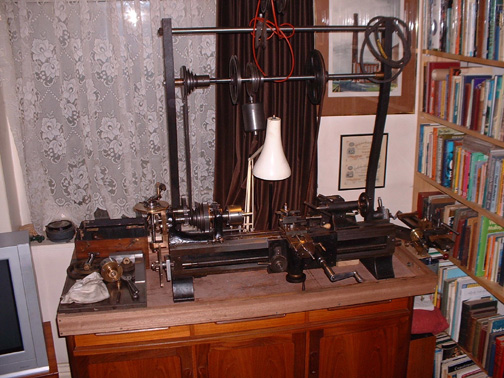
I've tidied up a bit before moving on to the next job in the refurb. I have made a bracket at the right hand side to store the slide rest and one or two other lumps when they are not in use. I've also replaced the 'V' belt drive from the motor by a 1/4 inch leather belt as it gives a softer drive, a better cut and is what Johnny would have used in 1927. I think my next move is to make up a proper set of change gears. I have quite a few of the originals but not a full set. Of course, that raises the immediate question, what is a full set? On the 122 lathe Johnny went overboard, I think there are about 40 gear wheels! I am not going for that standard. I shall have to put my thinking cap on...... I've just had a thought and got out my copy of Percival Marshall's book on Metal Turning and Screw-cutting. He started the Model Engineer and his book was published in hardback at three shillings. Don't know the date but he was used to old lathes. he says that a full set of change wheels consists of 22 gears from 20 to 120 teeth in increments of five with two 20 tooth wheels but ordinary requirements can be met by a lasser number of wheels. So that's the gold standard, I'd better count up and see what I've got and then decide what to do.
Stanley Challenger Graham

Barlick View
stanley at barnoldswick.freeserve.co.uk  |
andydiamond
Hairy Horologist


424 Posts

|
|
 Posted - 08/03/2007 : 20:46 Posted - 08/03/2007 : 20:46
The conversation about coffin plates spun out of a discussion on the price of brass back in the 1750's, when a lot of these clocks were made - - - -
From memory, iron was around one old penny a pound weight, but brass was about a florin ( 10 pence today ) a pound.
The clockmaker was often a farmer or weaver or smith, who made a clock every six months or so to supplement his meagre income.
Clocks back then were big and heavy, usually for a " grandfather " type of case, and the clockmaker was paid by the pound weight for the clock !!!
Half a crown ( 12.5 pence ) was the going rate, so if you do the math it's pretty obvious that the poor old clockmaker could in theory pay out 20 pence for the brass, spend six months of his spare time on a clock, then sell it for 12.5 pence - - - - - -er, hang on a minute - - - - - -
So Nollie, it does not take much imagination to see where the nice, thick, quality brass sheet came from - - - - I have repaired a few clocks which had " in loving memory of - - -" engraved on them, but tastefully turned round so the plain side faces out, you only see the engraving when stripping the clock for repair.
Private enterprise flourished even back then, and a little piracy went a long way when trying to bring up a family in very, very hard times, and, lets face it, there would be no complaints from the original owner of the plates !
The nice brass handles also came in useful for making some of the smaller parts in the clock - - - -
Another interesting spin-off here is that the clock case was usually made by the village joiner, who of course made the coffins for the village, and an old nickname for a longcase or "grandfather " clock was " coffin clock " - - -some of these early clocks in the provincial towns looked remakably like coffins when the movement was out for repair.
Now I wonder where the wood came from ?
( The joiner would have to be quick off the mark though, or the damp would spoil things a bit, not to mention - -- - - no, I'm not even going to go there - - - - - - - )
And they called them the good old days !!
Andy.
 |
andydiamond
Hairy Horologist


424 Posts

|
|
 Posted - 08/03/2007 : 20:53 Posted - 08/03/2007 : 20:53
I amost forgot in all the excitement,
Thanks for another enjoyable visit Stanley, and for the gifts of clock bits, not to mention the gallon of tea we supped - - - - -
The lathe that Stanley is restoring is SUPERB, the photos do not do it justice, and of course do not show the fine work that has turned into a labour of love, well done Stanley it is a credit to you.
Andy.
 |
Stanley
Local Historian & Old Fart
    

36804 Posts

|
|
 Posted - 09/03/2007 : 06:13 Posted - 09/03/2007 : 06:13
Thanks Andy, nice to know you noticed..... Mind you, it's easy to polish a diamond, you've got something good to start with. You'd have laughed if you had seen me last night. I got fed up with the telly and had a couple of cuts on the lathe just for amusement. The leather drive belt is not only an improvement but oh! the smell of new leather as it runs! Smells like a saddler's shop. I had a look at the original gears and I have 20, 25, 40, 100 and 120. I'll make a couple of new ones just for the joy of gear-cutting but I shan't go overboard, I'll do what Johnny would have done; leave it until I am short of a gear and then make one. first thing is to make a spare stud for the gears........ Lovely! (must run the vacuum over the carpet before the swarf treads in.....)
Stanley Challenger Graham

Barlick View
stanley at barnoldswick.freeserve.co.uk  |